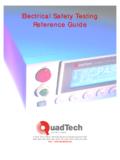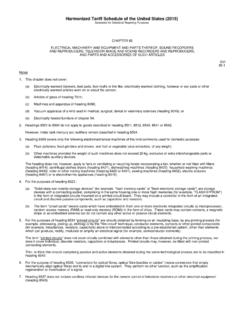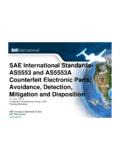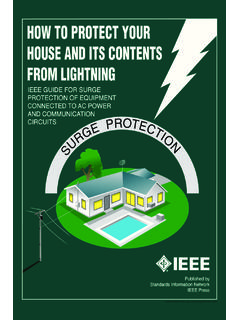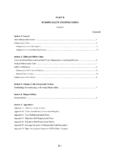Transcription of INTRODUCTION - Environmental technology
1 3 Reviews in Mineralogy & GeochemistryVol. 61, pp. 127-180, 2006 Copyright Mineralogical Society of America1529-6466/06/0061-0003$ : and Magnetic Properties of Sulfi desCarolyn I. Pearce, Richard Pattrick, David J. VaughanSchool of Earth, Atmospheric and Environmental Sciences, and Williamson Research Centre for Molecular Environmental ScienceUniversity of ManchesterManchester, United Kingdome-mail: metal sulfi des exhibit a great diversity of electrical and magnetic properties with both scientifi c interest and practical applications.
2 These properties apply major constraints on mod-els of the electronic structure (or chemical bonding) in sulfi des (Vaughan and Rosso 2006, this volume). The pure and doped synthetic equivalents of certain sulfi de minerals have actual or potential applications in the electronics industries (optical devices, photovoltaics, photodiodes and magnetic recording devices). Sulfi des are also components of many thin fi lm devices and have been extensively investigated as part of the nanotechnology revolution. Certain electrical and magnetic properties of sulfi de minerals mean they contribute to geomagnetism and paleo-magnetism, and provide the geophysical prospector with exploration tools for metalliferous ore deposits.
3 To the mineral technologist, these same properties provide methods for the sepa-ration of the metal-bearing sulfi des from associated waste minerals after mining and milling and before extraction of the metal by pyrometallurgical or hydrometallurgical this chapter, the theory and measurement of electrical and magnetic properties are outlined along with spectroscopic and diffraction studies that can provide insights into magnetic behavior are discussed. A brief review of electrical and magnetic studies of major sulfi de minerals includes some examples of the applications of sulfi de electrical and magnetic properties, including special consideration of the properties of sulfi de nanoparticles.
4 Most of the available data presented are for pure synthetic binary and ternary sulfi des, as very small concentrations of impurities can dramatically affect electrical properties leading to problems of interpreting data from natural samples. Although data for several of the commonly found sulfi des are discussed in this chapter, no attempt is made at a comprehensive section below on theory and measurement of electrical and magnetic properties draws on the account given in Vaughan and Craig (1978) to which readers are referred for further details.
5 It is useful to provide this overview as the electrical and magnetic properties of sulfi des provide critically important information for understanding them as materials, as well as giving rise to important applications. Also, the theoretical background is not commonly dealt with in texts concerning mineralogy or geochemistry, hence its inclusion AND MEASUREMENT OF electrical AND MAGNETIC PROPERTIESE lectrical propertiesMetals, in which characteristically high conductivity is associated with overlapping valence and conduction bands or a partly fi lled band (see below and Vaughan and Rosso 2006), 128 Pearce, Pa rick, Vaughanhave room-temperature conductivities which are largely independent of impurities or lattice defects.
6 Generally, the electrical conductivity ( ) is given by the expression: =Nem21()where N = concentration of free (conduction) electrons, e = electron charge ( 10 19 coulombs), m = electron mass, and = relaxation time (approximate mean time between collisions for the electron) This generalized expression derives from the free-electron model for metals. It shows that conductivity is mainly infl uenced by the number of conduction electrons ( , position of the metal in the periodic table) and the mean time between collisions which scatter the electrons.
7 The lattice vibrations causing the scattering clearly dominate at room temperature but would be expected to die out ( , would go to infi nity) at 0 K and the conductivity becomes infi nite in a perfect crystal. Since no real crystal is perfect, resistivity does not fall to zero and, at lower temperatures, impurities and defects have a marked effect. By contrast, the resistivity of metals at relatively high temperatures varies only slowly with temperature. The quantity e /m is defi ned as the mobility ( ) and is the drift velocity per unit electric fi eld.
8 The free-electron model from which these expressions are derived is a classical model which does not involve quantum mechanics and, although adequate in describing conductivity, breaks down when applied to other properties such as magnetic characteristically exhibit conductivity which increases rapidly as a function of temperature over certain ranges. In the pure intrinsic semiconductor a fi lled valence band is separated by a narrow energy gap from the vacant conduction band, although this situation is only really applicable at 0 K.
9 As the temperature is raised, the Fermi surface becomes fuzzy and electrons are excited above this level by thermal energies of amount kT, and as more and more of them receive enough energy to cross the forbidden gap and become effectively free, the conductivity increases. Impurities which act as donors or acceptors of electrons complicate the situation by having electronic energies that fall in the forbidden energy gap. The donor levels provide electrons for the conduction band and such (negative) electron conduction is called n-type, whereas in p-type conduction, the excitation of electrons from the valence band into acceptor levels results in (positive) holes in the valence band.
10 Both are examples of extrinsic semiconduction and both may occur in the same sample. If so, donor levels may empty into acceptor levels and when equal in concentration, effectively compensate for each other. Since intrinsic and extrinsic semiconduction are both temperature-dependent properties, many real examples exhibit temperature ranges over which either intrinsic or extrinsic mechanisms dominate. The concentrations of holes and of electrons in both the intrinsic and extrinsic ranges can be treated as problems in establishing chemical is important to emphasize that occupation of energy states by electrons in the valence band and conduction band of semiconductors is statistical, and dependent on the number of available states and on the absolute temperature.
